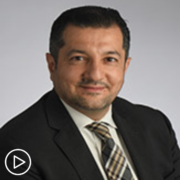Related Programs:
Transcript:
Katherine Banwell:
Hello and welcome. I’m Katherine Banwell, your host for today’s program. Today, we’re going to talk about how to live and thrive with an MPN. We’re going to discuss MPN treatment goals and how you can play an active role in your care. Before we get into the discussion, please remember that this program is not a substitute for seeking medical advice. Please refer to your healthcare team about what might be best for you.
Well, joining us today is Dr. Jeanne Palmer. Dr. Palmer, welcome. Would you please introduce yourself?
Dr. Jeanne Palmer:
Thank you so much. I am so happy to be here and to help participate in this. My name is Jeanne Palmer. I am a hematologist at Mayo Clinic in Arizona. I specialize in MPNs as well as bone marrow transplant, and I am thrilled to be here.
Katherine Banwell:
Thank you for taking the time out of your busy schedule to join us today, Dr. Palmer. We start all of the webinars in our Thrive series with the same question and that is, what does it mean to you to thrive with an MPN?
Dr. Jeanne Palmer:
I think living with an MPN can be very difficult. I think there is a number of things. First of all, there’s always the worry of what’s going to happen in the future. Many of these MPNs can start as fairly, for lack of a better term, as benign issues and can convert to something much more serious. So, I think living with that sort of timebomb in the back it can be extremely stressful. So, figuring out how to live with the fact that there is some degree of uncertainty.
I think the other thing is making sure to understand your disease. These are very rare disorders and even if you go to a hematologist-oncologist specialist, a lot of times they don’t have all the information because they don’t see a lot of them every year. So, it’s really important to make sure that above and beyond that you understand what’s going on in your body so that when new things happen, new symptoms happen, you’re able to really address them as opposed to sort of living with something that may make you feel poorly that’s not being addressed.
So, again, I think the biggest piece of this is seeing how do you live with uncertainty, and how do you make sure you understand your disease well enough that you know what’s going on in your own body.
Katherine Banwell:
Yeah. That’s helpful to understand, especially as we move through today’s program, and we’re going to cover the three classic MPNs, polycythemia vera, essential thrombocythemia and myelofibrosis. One part of thriving with an MPN is managing the symptoms of the disease. Would you walk us through the common symptoms of each of the MPNs? Let’s start with essential thrombocythemia.
Dr. Jeanne Palmer:
Right. So, there are a number of shared symptoms throughout all the diseases and when we start to figure out how to categorize them, they call into several different categories. The first one is inflammation-related symptoms. We know that the inherent pathway that’s dysregulated or that causes these diseases to happen can also result in significant inflammation in a person, that can result in things like fevers, night sweats, weight loss, and overall feeling really fatigued and poorly, which is something that it seems to be much more prevalent in patients with MPNs, all sorts of them, actually.
The next set of symptoms is related to microvasculature, so all the little blood vessels. And sometimes we think, oh, maybe that’s because there’s too many red blood cells or platelets and the blood become viscous. It’s probably more related to the actual dysregulation of that JAK2 pathway, which is inherent to all the myeloproliferative diseases and as a result, the little blood vessels can clamp down and that can give people headaches, visual changes, numbness and tingling in the hands and feet, and even can cause sort of a painful rash called erythromelalgia in the body.
So, these are things that can happen that are probably less appreciated side effects of the disease. And finally, there’s spleen-related symptoms. The spleen is in the left upper quadrant of the abdomen and it’s an organ that generally is about 12 centimeters in length, 10 to 12, but in patients with myeloproliferative diseases it can be enlarged. And as a result of an enlarged spleen people can have feeling like they get fuller early. So, if you’re eating a meal, all of the sudden you can only eat half of that meal versus the whole meal.
Discomfort or pain in the left upper quadrant. Sometimes it’s much more noticeable when you like bend over to tie your shoes. And then sometimes people can actually, when the spleen gets really big, the blood flow can be impaired towards the end of it which can cause some of the spleen tissue to die, and that can be painful. So, these are things that if somebody does start to notice that they’re having fullness in the left upper quadrant, pain, stuff like that, that that may be related to spleen symptoms.
Katherine Banwell:
What about PV or polycythemia vera, what are the symptoms?
Dr. Jeanne Palmer:
So, all of these sorts of relate to all of the myeloproliferative diseases. So, one other one that I didn’t mention, and this is actually more in PV than others, is itching. Itching can be absolutely unbearable when somebody has PV. It’s particularly noticeable after taking a shower. So, a lot of times I’ve met patients who are like I haven’t been able to take a shower in years, because it causes such a high degree of itching.
Katherine Banwell:
Why a shower? Is it different from having a bath?
Dr. Jeanne Palmer:
Water on the body that can cause the problem. So, if people take hot showers, it’s even worse. Although I think that people sort of react to it differently. Usually what patients end up doing is more like sponge bath type of things, rather than actually being exposed to the water.
Taking colder showers or cooler showers can sometimes help mitigate that. But the itching, and even in the absence of a shower, people can have pretty severe itching, and that can also be one of the major side effects.
Katherine Banwell:
Much of the time the chosen treatment for MPNs manages the symptoms of the condition. I’d like to review the different types and classes of treatment for the three MPNs. So, let’s start with essential thrombocythemia again. When is it time to treat, and what are the options available?
Dr. Jeanne Palmer:
Right. So, with essential thrombocythemia, that’s the disease that sometimes we don’t need to treat.
So, we basically have a risk stratification system and this risk is based on age, history of a blood clot, the presence or absence of a JAK2 mutation. So, for example, if somebody is 28, does not have a JAK2 mutation, which is again one of those driver mutations, and never had a blood clot, they actually don’t necessarily need to do anything and just be monitored.
Somebody who is less than 60 and has a JAK2 mutation or who is greater than 60 and does not have a JAK2 mutation, in that setting, a lot of times you can use aspirin. Now, it gets a little bit gray in terms of that over 60 without the JAK2 mutation with regards to whether at that point you really should start taking some medicine to lower the platelets.
Now, if somebody has a JAK2 mutation, is greater than 60 or has had a blood clot, hands down they need to take medicine to lower the platelets, in addition to aspirin or whatever blood thinner they may need. So, for example, if you have a blood clot in a vein, a lot of times you need to take a blood thinner and that will be a lifelong thing. And again, we do these risk stratifications because we know there is a certain risk of clotting associated with the risk of essential thrombocythemia.
So, for example, somebody who is less than 60 and does not have a JAK2 mutation, never had a clot, their risk of clotting is probably very close to that of the normal population. Whereas if you’re higher risk and have a JAK2 mutation and greater than 60 or have had a history of a clot, the risk of clot is probably about 4 percent per year. So, this is something that can vary quite widely, and even though that 4 percent per year on the short-term doesn’t sound like a lot, if you take it additive over years, that’s why we generally try to be aggressive about lowering the platelets.
In lowering the platelets, the goal is to get less than 400 and doing that can be done through several different medications. The most commonly used medications is a drug called hydroxyurea, which has been around for a number of years, and a drug called anagrelide which is probably a little less commonly used, because it has some more GI side effects and headaches associated with it.
In some cases, especially in younger patients with this disease, we can consider using interferon, which is an injection of a cytokine, which are one of the chemicals that regulates the immune system within the body. But this interferon can actually help lower the platelets and there is a question of whether it may affect the biology of the disease as well.
Katherine Banwell:
Let’s turn to polycythemia vera or PV, what are the different options available for treating it?
Dr. Jeanne Palmer:
So, for polycythemia vera, everyone needs to be on aspirin.
And additionally, everyone needs to make sure to keep their blood count low, to manage their hematocrit, which is one of the measures of red blood cells. So, in men it’s generally recommended to keep below 45 and in women it’s recommended to keep below 42 percent. Now, the studied number was 45 percent and that was a study that was done, I don’t know, it was probably about 10 plus years ago, that actually showed that by keeping the blood hematocrit less than 45 percent you reduce the risk of having negative events like cardiovascular events and heart attacks. Because women tend to run with a lower blood count than men, it’s been extrapolated that 42 percent should be the number used for women.
Now, this can be done by phlebotomy, which essentially is bloodletting. It’s kind of like donating blood except for that the blood unfortunately can’t be donated to anybody, it has to be discarded. But the phlebotomy is one way to do that, and the reason that works is because it makes somebody iron deficient. So, whereas if this is normal, if you’re iron deficient you become anemic. If your baseline hematocrit is here, making you iron deficient brings you back to normal. So, even though we always associate iron deficiency with anemia, iron deficiency in the setting of polycythemia vera is actually kind of a treatment of sorts.
Now, once somebody gets above 60 and 60 seems to be sort of the magic age in these diseases, once somebody gets above 60, it is recommended that cytoreductive therapy is used, which means therapy or treatment that will bring down the red count. And again, for this one, hydroxyurea is an option as well as interferon. And there is recently an approval, actually FDA approval for a newer interferon called ropeginterferon or Besremi, which can help just bring down the red blood cells but it is the first interferon that’s actually been FDA approved for this indication.
Katherine Banwell:
Are JAK inhibitors used as well?
Dr. Jeanne Palmer:
They are. So, if somebody doesn’t respond well to hydroxyurea, the approval for ruxolitinib is actually for patients who have failed hydroxyurea. Although it’s something that we often consider especially in people who have a lot of symptoms. So, the itching, one of the things that can really help itching actually is Jakafi. If people have night sweats, they have weight loss, spleen related symptoms, those are the patients that will benefit from Jakafi. Additionally, if they are on hydroxyurea and can’t seem to get control of their blood count, Jakafi is a good option to help control the blood counts as well.
Interferon is a very nice option because there’s great data that shows that you may actually be able to lower the percentage of JAK2 burden.
So, we’d look at something called an allele burden, which is the percentage of cells that are involved – have the JAK2 mutation. Now, we don’t know whether lowering this percentage necessarily translates to long-term better survival, but I think there is enough data out there, and there is a good biologic underpinning for saying that this actually can help. But yes, Jakafi is another thing.
And the really exciting thing is that there is a newer agent called rusfertide, which is a hepcidin mimetic, which is basically taking a protein in your body that helps metabolize iron and by making it externally and giving it to somebody that it can actually help bring down the hematocrit without having some of the other side effects we know with some of the other medications. That is currently in Phase III studies, so hopefully in the next couple of years we’ll see approval for that.
Katherine Banwell:
Oh, that’s great news. And finally, how is myelofibrosis treated?
Dr. Jeanne Palmer:
So, myelofibrosis is a little bit of a different animal. When you have something like essential thrombocythemia or PV, a lot of this is managing symptoms, preventing blood clots, but if you do appropriate treatment and management of these diseases you could probably live close to a normal life expectancy.
So, I never typically pin a survival on it. With myelofibrosis, it’s a little bit different because there is a survival. Instead of saying you can live close to normal life expectancy, it backs up to saying how many years do I think you can live with this disease. Now, of course, we are horrible at predicting how many years anyone can live, so we have to take that all with a grain of salt. But we can at least sort of risk stratify people.
And the first thing that’s really important is to figure out whether somebody is a transplant candidate or not and if, based on age, disease risk features, stuff like that, or whether we think they ever will be a transplant candidate. So, that kind of helps us sort of think about what your path moving forward is.
Now, the current FDA-approved treatment for myelofibrosis, there are three JAK inhibitors approved, which is like Jakafi, which was the first approved one but there is also Inrebic or fedratinib and Vonjo or pacritinib and these have all been approved over the years.
The role of JAK inhibitors and treatment of myelofibrosis is symptoms-based. So, for example, a lot of patients with myelofibrosis will have weight loss, night sweats, big spleens, really feeling fatigued and poorly and in this setting, the JAK inhibitor can be very helpful. And you don’t have to have a JAK2 mutation, a lot of times people say, well, I don’t have the JAK2 mutation so how can a JAK inhibitor help. So, the JAK inhibitor works on this pathway, which is called the JAK/STAT pathway, irrespective of mutation.
So, if you are having symptoms and you have myelofibrosis, JAK mutation, excuse me, the JAK2 mutation does not predict who is going to have a response. And people who, regardless of which mutation you have, may actually benefit from it.
So, the JAK inhibitors, though, are extremely effective at reducing symptom burden as well as reducing the spleen size. And we know that if a spleen is big and we can make it shrink that, that probably is a surrogate marker for living longer, and I think it’s because inflammation does a lot of wear and tear on the body. So if you can reduce the inflammation and the spleen shrinks, which generally go hand in hand, then you might help somebody live longer. It is not changing the biology of the disease, though, however, it doesn’t change the pathway and that this disease is kind of projecting ahead in terms of creating – it changes, as it goes along, may acquire new mutations or something like that which makes the disease become more serious.
Right now, the approved therapies for it are JAK inhibitors and the Jakafi, ruxolitinib was the first one approved. Inrebic was approved several years back, or fedratinib.
And then the most recent one that was approved is Vonjo or pacritinib and that’s a drug that is a JAK inhibitor that is actually very good for people with low platelets. The reason I bring that up is because if we think of what’s the biggest limiter of JAK inhibitors, JAK inhibitors bring down red blood cells, and they bring down platelets. So, when somebody has low platelets it’s very hard to use a JAK inhibitor, because we’re not really able to increase the dose well enough to get that inflammatory reduction because of the fact that the blood counts will drop too low.
So, now drugs like Vonjo exist which, due to several other mechanisms associated with the drug are actually much more tolerated in somebody with low platelets. So, if you have low platelets, you can actually take the Vonjo, hopefully get the same degree of JAK inhibition to help the spleen shrink, help the symptoms get better without necessarily making the platelets substantially worse. A lot of times they do drop, it doesn’t help bring up the platelets, but it does help people tolerate more JAK inhibition, which ultimately will help with symptoms.
Dr. Jeanne Palmer:
So, one thing I also wanted to add about myelofibrosis treatment is sometimes people present, they don’t have a lot of symptoms, they don’t have a lot of spleen related problems but they have anemia or low blood counts and these can be incredibly hard to treat.
Even with symptoms and low red blood cell count or anemia or low platelets, it can be challenging to treat because many of these medications lower that. To treat the anemia there are several things that we can do. One of the first ones is using erythropoietin, and so there are many agents, they go by the names of like Procrit or darbepoetin alfa, that actually stimulate red blood cell growth by – like we give a recombinant hormone that helps red blood cells grow. This is normally something produced by the kidney.
So, one thing that’s important before going on one of these injections is to make sure that the kidney is not already producing enough. So, for example, if the kidney said, oh geez, I really need more red cells and is making lots of this hormone, erythropoietin, giving more of it is not going to help the system. But in people who don’t have a really high level it can be very beneficial.
The other thing that can help with anemia, specifically, is a drug called danazol (Danocrine).
It’s been around for a very long time. There are multiple presumed mechanisms of action, but one of them is that it is kind of a testosterone derivative. So, this is a medicine that can often help increase red blood cells in probably about 40 percent of people, and it’s a pill that you take twice a day.
Another option, sometimes we use thalidomide or lenalidomide (Revlimid). These are medications that have been used quite frequently in the setting of multiple myeloma and even a little bit in myelodysplastic syndrome, so some other blood disorders.
But in the setting of myelofibrosis, they can be helpful with anemia and sometimes are combined with prednisone or a corticosteroid. And then finally, in terms of drugs that are being tested and hopefully will be approved at some point in the future. There is a drug called momelotinib, which is another JAK inhibitor that actually has some mechanisms that may also help improve hemoglobin.
So, this is something I’m really looking forward to and we anticipate may be approved by the end of the year. And finally, there is another drug called luspatercept (Reblozyl). Luspatercept may work in the setting where your kidneys are already producing enough erythropoietin. So, the luspatercept is an injection that you receive once every three weeks.
It is currently FDA-approved for the treatment of myelodysplastic syndrome but this is something that has been shown to have some efficacy in myelofibrosis as well. So, this could be another therapeutic option for patients with myelofibrosis.
It is also important, especially for people who have polycythemia vera myelofibrosis to make sure that your iron has been checked and B-12 has been checked, because just because you have a bone marrow disorder doesn’t necessarily mean you don’t have a nutrition deficit that may be able to help improve your hemoglobin somewhat. But these are important things to talk to your doctor. I do not recommend just starting to take iron or B-12, however, if you’re anemic because in many cases you are not deficient and taking too much iron can actually be damaged.
Katherine Banwell:
Yeah, that’s great advice.
When would you consider a stem cell transplant?
Dr. Jeanne Palmer:
So, the stem cell transplant is based on disease risk. There is a number of ways we assess disease risk. The first two ones that were published a number of years back were the DIPSS score, which is Dynamic International Prognostic System Score, or the DIPSS Plus, which basically is the DIPSS and then you add to it a few other clinical features. This symptom score is based largely on things that we can see without even a bone marrow biopsy, so things like symptoms, age, number of white blood cells, whether somebody has anemia. And then the number of something called blasts, which is very immature white blood cells. The DIPSS Plus takes into account low platelets, need for transfusions, and chromosome abnormalities, which is the only test among that that needs to be from a bone marrow biopsy.
Now, these were created prior to Jakafi being commercially available. So, we have to take a little bit of a grain of salt with those because of the fact that Jakafi probably has changed how long people can live with this disease.
Now, more recently they’ve tried to account for these other molecular changes. So, when we take the genetic landscape of these diseases, we have the known driver mutations, so the JAK2 mutation which I have talked about, also calreticulin and MPL.
These three mutations all affect that one pathway, the JAK/STAT pathway, so they all affect the pathway that drives the disease and they are known to be kind of mutually exclusive and definitely contribute to the formation of the disease.
Some of these other mutations are called somatic mutations. They could be checked by things next generation sequencing or genetic analysis. There’s a number of different names that people use for this testing, but we look for mutations that are present and these mutations, number one, can sometimes tell us risk. So, there’s certain mutations that are high risk. Other times it can actually give us other opportunities for therapy, especially of the disease progresses. But these mutations are important to know for risk stratification. For example, if somebody has DIPSS score that is maybe not super high risk, but then they have one of these mutations, we know that that probably makes their disease a little bit more aggressive.
And that’s when we think about transplant, is when we know that the disease probably has an average life – when somebody gets to the point in their disease where we estimate their life expectancy is around five years, recognizing that we’re not very good at this. That is the type of point when we start to think about transplant. But the timing of transplant is something that’s extremely difficult and a very personalized decision. It’s something that it’s really important to understand the disease risks, how we assess them and the caveats of these disease risk assessments as we move forward planning and timing of transplant and that’s something that is, again, a very, very important discussion to have at length with your physician.
And I always recommend, there is quite a few of us out there who actually specialize in transplant for myelofibrosis and having discussions with somebody who really understands the biology of the myelofibrosis and important because it’s very different than a lot of the other diseases that are transplanted.
Katherine Banwell:
Yeah. Well, speaking of that, patients can sometimes feel like they’re bothering their healthcare team with their comments and questions. Why do you think it’s important for patients to speak up when it comes to symptoms and side effects?
Dr. Jeanne Palmer:
Well, there is a lot of things. This is a disease, again, that we can direct our therapy many times towards symptoms, and so when we think about how do I direct my therapy, so how do I treat somebody, symptoms are an incredibly important part of it. And there is nothing worse than having a patient come and see me who I see every six months, because they’ve been pretty stable and they’re like, “Oh, for three months I’ve been feeling awful.” And you’re like, well, “Why didn’t you let me know, we could do something about this?”
So, if there is something that doesn’t feel right, it’s very, very important to talk to your healthcare provider. I would much rather be bothered and handle something earlier on than miss something and really have a lot more catch-up to do afterwards.
The other thing is symptoms may indicate a blood clotting event. We know that patients will have a higher risk of blood clotting. These are extremely important to identify early on because if they go unchecked, they can cause more damage.
Katherine Banwell:
With many of the treatments available as pills now, patients have a role in self-administering their treatment regimen. What happens if a patient forgets to take a medication? Does it impact its effectiveness?
Dr. Jeanne Palmer:
Generally no. I think the ones that would are certain blood thinners you really don’t want to miss and you don’t want to miss the doses on it. With drugs like Jakafi, if you miss one dose you probably won’t notice it, but if you miss multiple doses you can actually get very sick from that. So, some of these medications are really important to be consistent on.
Now, I know this could be a challenge. I mean I don’t take very many medications and I sometimes have a hard time keeping track of what I take, so I know that this can be a difficult thing to do. So, one thing is if you really find you’re struggling with it, setting an alarm on your phone or your Apple Watch or whatever…
Katherine Banwell:
…device.
Dr. Jeanne Palmer:
Device you have can be a really helpful way of doing it. Also having a pill box. They make pretty amazing pill boxes these days that can account for taking drugs once a day, twice a day, three times a day. I’ve even seen them up to four times a day, although generally the most you’ll probably have to take a medicine for a myeloproliferative disease is twice a day. But those are different ways that can really help make sure you’re consistent about taking your medication.
Katherine Banwell:
And if a patient misses a dose, do they need to call their healthcare team and let them know?
Dr. Jeanne Palmer:
Not just for one missed dose. If like, for example, they’re run out and they say, “Oh, geez, I don’t have any and many of these drugs are specialty pharmacy,” so they need to be mailed, and you know that you’re going to be missing it for a while. Or let’s say you look at your pill bottle and go, “Oh shoot, I only have so many pills left,” it is helpful to call because a lot of times, for example, if somebody is on Jakafi and they know they’re going to run out of their pills four days before they’re going to get their next shipment in, then what I sometimes do is I lower the dose a little bit to make sure they maintain a dose throughout that time.
But this is something you definitely want to do under the advice of a healthcare provider. You don’t want to just all of the sudden go, “Oh, well I’m going to run out so I’m just going to change my dose,” and kind of do that.
Katherine Banwell:
Yeah, yeah. We received some audience questions prior to the program today. This one is from Jacqueline, “What can I do to minimize pruritus or itching due to PV? A typical histamine blocker like Claritin or Zyrtec has done nothing whatsoever.”
Dr. Jeanne Palmer:
Yeah. Unfortunately, the itching of this is not as much mediated by an allergic type reaction or histamine. It’s a lot related to that microvasculature, those tiny little blood vessels. Things like avoiding hot showers, as we talked about, taking cooler showers or not even taking showers, just like cleaning yourself with a washcloth can be helpful. There are certain medications that we can use sometimes that help.
Now, first of all, Jakafi is extremely effective for itching. Of course, it does have side effects. It’s not always approved for your disease, so for example, it’s not approved for essential thrombocythemia. But JAK inhibitors can be helpful in that setting. There are also medications like Gabapentin, which is a medicine that we use to treat peripheral neuropathy and that can actually be helpful because actually the itching, a lot of it is related to nerves not functioning right, so gabapentin can be helpful.
And a really old-school medicine that I sometimes use, especially if the itching is most prevalent at night, is a drug called Doxepin and that’s been around for a very long time, but it can be extremely sedating and has to be used with caution, especially in patients who are older.
Katherine Banwell:
Here is a question from Daniel. “How often should a person with PV have hematology appointments, and how often should you have blood tests?”
Dr. Jeanne Palmer:
Well, that is something that you need to discuss with a provider, because everyone’s a little bit different. If I have somebody who I’m managing on a medication, they’ve been rock solid stable, it may be every few months that I check blood and maybe every six months that I see them.
If I have somebody who have been particularly difficult to control and I’m sort of adjusting medications or they’re having symptoms, then I try to check blood more regularly, like on a monthly basis. But again, this is something that – I have checked blood as frequently as every two weeks, especially in somebody who has an extremely high red blood cell count that I’m trying to lower. I have checked blood as infrequently as every three months. Again, in somebody who is not undergoing treatment, say, for example, who has essential thrombocythemia, sometimes I check blood even less. So, it really is something that can vary from every two weeks to every six months.
Katherine Banwell:
Okay. Katie had this question. “What are the signs of progression from PV to MF or AML, both clinically and in blood tests, and when do you need a new bone marrow biopsy to check for this happening?”
Dr. Jeanne Palmer:
So, in terms of progression, there are several things that we see happen.
I think most importantly is, let’s say you have PV, and you’ve always been on medication, and it’s been hard to control. And all of a sudden, you don’t need medication to control it anymore, or the same thing for essential thrombocythemia. You have been taking medication, and all of a sudden your platelets go down, and you don’t need to take drugs anymore. A lot of times people are like, “Oh, that means I’m fixed and I’m well,” not necessarily, you really need to make sure to talk to your healthcare provider and potentially get a bone marrow biopsy.
Now, the other thing – sometimes the blood counts will actually drop too low, so you’ll have somebody who has PV, who has always been too high and then all of the sudden they come in, and their hemoglobin is very low, and they’re anemic, and that’s another situation where you do that. So, anytime the blood counts start to drop is concerning.
Now, it’s a continuum, so the blood counts may drop as you’re at the point of transitioning but it doesn’t – it’s not like if your blood count is dropping you say, “Oh my God, I have myelofibrosis, I need a bone marrow transplant tomorrow.” That’s not necessarily the case. This is generally a transition type process.
Also when the spleen starts to get enlarged. Now, the spleen can be enlarged even in the setting of just ET or just PV, so spleen enlargement does not necessarily mean you’re transforming, but it can be one of the things that we would see that would indicate that.
Katherine Banwell:
Okay.
Dr. Jeanne Palmer:
And then finally white blood cell count increasing can often be a sign of that. Now, in terms of progression to AML, that is generally something we’ll see in the blood. AML or acute myeloid leukemia, is indicated by the presence of blasts at greater than 20 percent. Now, many patients with myelofibrosis, in particular, but even PV and ET, may have blasts in their peripheral blood. Blasts are normal. If I did a marrow on every healthy person out there, they are going to have some blasts, because these are the first part of the development of white blood cells. So, they’re like baby white blood cells. But what the problem is, is when they start to grow too much.
And so in the setting of myelofibrosis and even sometimes with these other diseases, the blasts will be in the peripheral blood primarily because the bone marrow is damaged and doesn’t hold them in very well. It becomes AML when it gets greater than 20 percent, so that blasts of greater than 20 percent in the peripheral blood or in the bone marrow but a lot of times we find it in the peripheral blood is where we indicate this has progressed to AML.
Katherine Banwell:
Yeah.
Dr. Jeanne Palmer:
Blasts of greater than 10 percent are also something that we really want to pay attention to, because that would suggest that the disease is starting to become more aggressive. Now, blasts vary, so for example, I’ve had patients go up to 11 and then drop back down to 3 or 4, and then they say around 3 or 4 or 5. So, you always want to make sure to double-check because one blast count at 11 percent, whereas it’s very important to address, may not necessarily reflect that you need to change in treatment at that time. Again, these blood tests, I always tell people, do not freak out over one blood test.
Make sure you get at least a couple of them to really confirm what you are looking at.
Katherine Banwell:
Thank you, Dr. Palmer. And to our viewers, please continue to send in your questions to question@powerfulpatients.org and we’ll work to get them answered on future webinars.
Dr. Palmer, was we close out this conversation I wanted to get your thoughts on where we stand with progress in helping people live longer and truly thrive with MPN. What would you like to leave the audience with?
Dr. Jeanne Palmer:
So, I think that the first thing is make sure you understand your disease. Don’t hesitate to ask for a second opinion. It’s always good to make sure you talk to someone who can really explain so you feel like when you go home you understand what’s going on in your body. Make sure you understand what symptoms to look for, what things to be aware of, because a lot of times people come in and they have no idea that, oh, these symptoms are actually related to their disease.
The other thing to make sure is that you’re very honest with your provider on how you’re feeling. A lot of times people come in and they say, “Oh, how are you feeling?” “I feel fine,” but then they start to ask very specific questions and they’re like, “Oh yeah, I’m really tired, my fatigue is an 8 out of 10,” or something.
So, make sure you’re really honest with your provider. When they ask you how they’re doing, this is not a social visit, this is a visit where they need to know your symptoms, so you don’t need to say I’m fine like you normally would if you were walking down the street.
The next thing is to always make sure to know where there’s clinical trials because we are making enormous great leaps and bounds in this field. It’s a really exciting time for myeloproliferative diseases, and there’s a number of new drugs that are being tested and coming out. So, it’s always important, if the opportunity is available and you can do it, clinical trials are a great way to get treatment.
Plus, you are giving back, because these are things that help us learn whether something works or not. So, you’re not as much a guinea pig, you never get a sugar pill. It’s one of those things you will always get the treatment you need and then they may add something to it or you may be in the situation where there is no treatment, so they try something.
But clinical trials, I have to emphasize, are a great way to get therapy and really are how we know everything that we know about treatment for these diseases.
Katherine Banwell:
Yeah. It sounds like there’s a lot of progress and hope in the field.
Dr. Jeanne Palmer:
Oh, absolutely.
Katherine Banwell:
Thank you so much, Dr. Palmer, for joining us today.
Dr. Jeanne Palmer:
You are very welcome, my pleasure, and it’s always fun to do these things, so thank you for having me.
Katherine Banwell:
And thank you to all of our partners. To learn more about MPNs and to access tools to help you become a proactive patient, visit powerfulpatients.org. I’m Katherine Banwell, thanks for joining us today. z






























